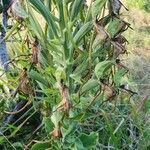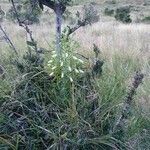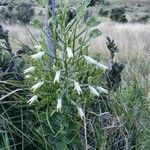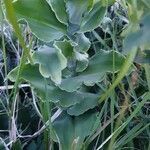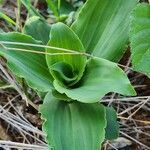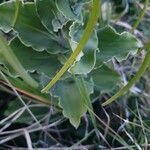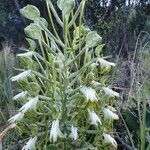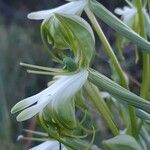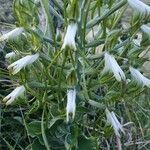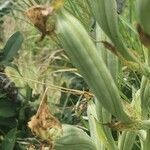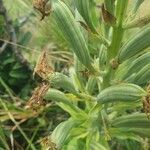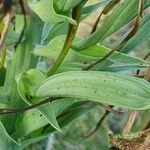Erect, decumbent or scandent terrestrial herbs, 415-981 mm tall; tubers 1-6, spreading, elongate-oblong, tomentose. Stem robust, 405-976 x 4.0-15.5 mm. Leaves 7-20, lax to dense, cauline, lower sheathing, blades reduced, oblong-lanceolate to ovate-elliptical, acuminate, margins entire, smooth to undulate, 56-154 x 16-56 mm. Inflorescence cylindrical, 92-304 x 120-289 mm, lax, 5-35-flowered; bracts sometimes withered at flowering, similar to upper leaves, sheathing, lanceolate to ovate-lanceolate, apiculate, 24.5-50.5 x 5.5-15.0 mm. Flowers spreading, green and white, pedicel and ovary, sub-erect, 4480 mm long. Dorsal sepal green, erect, narrowly-elliptical, galeate, acute to acuminate, 19-25 x 5.5-9.0 mm; lateral sepals green, projecting forwards, weakly to strongly deflexed, ovate-lanceolate, acuminate to apiculate, base oblique, margins weakly to strongly revolute with acute tooth on lower margin, 17.5-27.5 x 8.5-12.5 mm, adnate to lip and stigmatic processes for 7.0-17.5 mm. Petals upper lobe green, erect, linear, acute to acuminate, 18-26 x 0.5-2.0 mm, adnate to dorsal sepal, lower lobe white with green tip, spreading horizontally, strongly deflexed, linear-falcate, acuminate to apiculate, 39-75 x 0.5-2.0 mm, adnate to claw of lip for 5.0-15.5 mm. Lip green, claw 14.0-36.5 mm, median lobe descending, geniculate, apically recurved, linear-lanceolate to narrowly-oblong, acute to acuminate, 22-43 x 1.0-2.5 mm, lateral lobes descending, diverging, linear-falcate, tips curved, acuminate, 35.5-60.0 x 0.5-2.0 mm; spur toothed, 75-230 mm long, clavate apex 22-49 mm long. Anther erect, acute, 7.5-11.5 mm long, canals slender, 18.5-26.0 mm long. Stigmatic processes clavate, projecting forwards and deflexed, sub-parallel, 24.5-33.5 mm long, base adnate to lip. Rostellum 3-lobed, base auriculate, median lobe cucullate, apex incurved, apiculate, margin ciliate, 6-10 mm long, lateral lobes linear, fused to anther canals, projecting forwards to sub-erect 45°, sub-parallel, 6.0-15.5 mm long.
Petals 2-lobed almost to base; posterior lobe erect, adnate to dorsal sepal, 21–24 × 1–2 mm; anterior lobe 50–70 × c. 1 mm, adnate to claw of lip for 6–20 mm, then curving down and outwards; both lobes linear, the anterior becoming ± filiform.
Lip with basal claw 15–30 mm long, then 3-lobed; mid-lobe 20–37 × 1–3 mm, linear, tapering, decurved; side lobes 25–85 × 1–2 mm, spreading, linear, tapering, longer and narrower than mid-lobe.
Dorsal sepal erect, 2.2–2.5 × 1.4–1.6 cm, ovate, acute, very convex; lateral sepals deflexed, 2.3–2.6 × 1.1–1.3 cm, broadly lanceolate, apiculate.
Stigmatic arms projecting forwards, 22–32 mm long, the basal third to half adnate to the lip, the free part club-shaped.
Stem erect, leafy; leaves 7–12.5 × 3–4.5 cm, ovate, acute or apiculate, not overlapping, the base clasping the stem.
Inflorescence fairly laxly 3–30-flowered; ovary and pedicel 5–6 cm long; bracts ± scarious, c. 4 × 1 cm.
Rostellum placed in front of column, mid-lobe 5–8 mm long, side lobes slender, 10–20 mm long.
Terrestrial herb up to c. 110 cm tall; roots villous, thick, fleshy and tuberous.
Anther 10–18 mm high, loculi parallel; canals slender, 18–25 mm long.
Spur 10–21 cm long, pendent, slender but slightly swollen at apex.
Flowers spreading, mainly green, white in centre.
